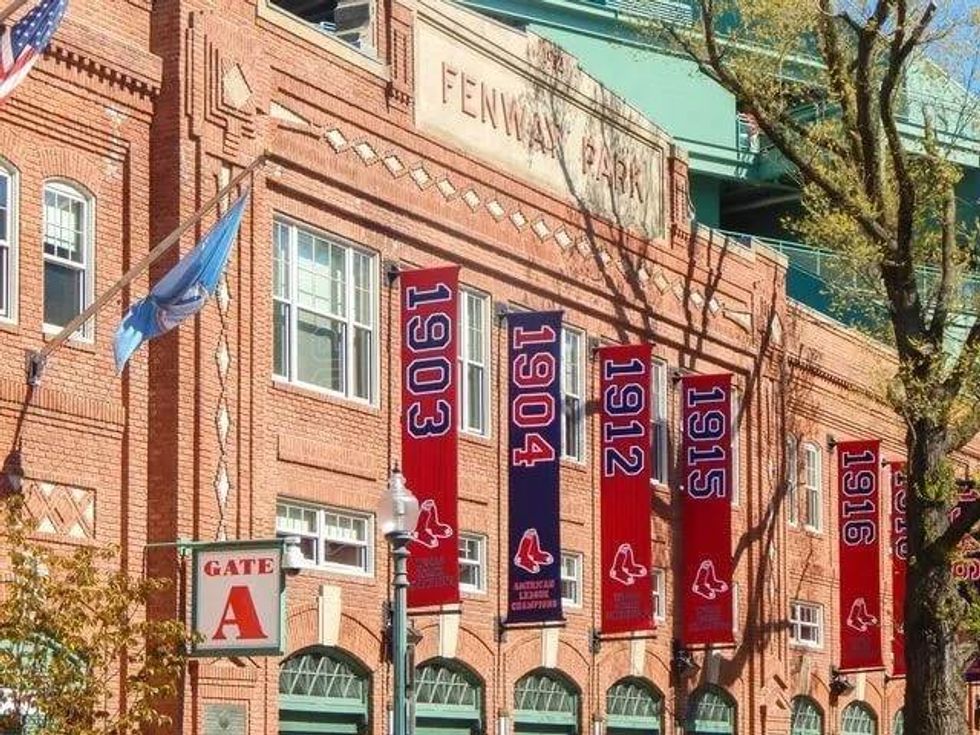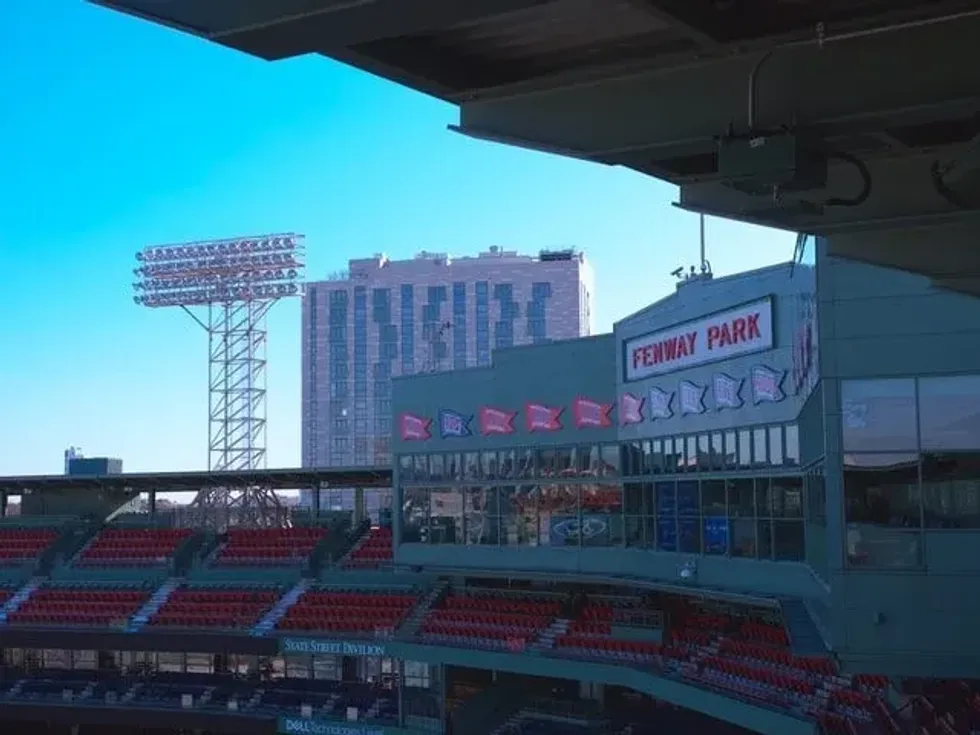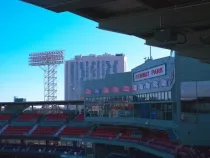81 Cool And Fun Fenway Park Facts That You May Not Know!

Fenway Park is home to the Boston Red Sox and the Boston Braves and hosts major league baseball games.
It is also actually one of the oldest active baseball parks in America. It is a public park that is now infused with a deep tradition and history, fans of Red Sox or Braves will intuitively recognize the Fisk Foul Pole and know all about the lone red seat as well as the famed green monster!
Read on to learn more about this famed stadium and the greats that graced this place.
Location Of Fenway Park
Fenway Park is located in a part of Boston known as Fenway-Kenmore, fairly close to Yawkey Way.
The Red Sox owner John Taylor spent close to $650,000 to get the park constructed on a patch of land that he inherited from his father.
The total area of this land was around 365,000 sq ft (33,909 sq m).
The work on the stadium started in September 1911, and it wasn't until April 1912 that a game of baseball was played at the stadium. Therefore, by all considerations, work on the stadium had happened at a considerable pace!
The park had been designed by James McLaughlin, and Red Sox owner John Taylor decided the name Fenway Park after a company that his family owned at the time, thereby helping promote it to a large audience through the park.
When the park opened, its first major league basketball game was scheduled to happen on April 18, 1912, but rain played spoilsport, and thus, that game could not commence.
When the Red Sox game finally took place on April 20, the away team, New York Highlanders, suffered a defeat at the hands of the Red Sox.
For the first-ever baseball game at Fenway Park, the mayor of Boston, John Fitzgerald, threw out the first pitch. He was the grandfather of John F. Kennedy.
Incidentally, as some Red Sox fans may be aware, the New York Highlanders were not yet called the New York Yankees, one of the biggest teams in the MLB with which the Red Sox have an intense rivalry; that has lasted over a century!
This rivalry was started when, in 1919, the most popular baseball player was sold to the Yankees. And who was this player? None other than Babe Ruth, of course.
Once Babe Ruth had gone to the Yankees, the Red Sox did not win a World Series title for the next 86 years!
This led to a popular belief that the Red Sox had been cursed and the curse was called the 'Curse of the Bambino'.
The opening that was scheduled to take place on April 18 finally saw the light of day (quite literally) on April 20.
The Titanic had sunk just a few days ago, and public sentiment was very strongly empathetic towards that occurrence.
The dedication ceremony for the inauguration of the ballpark was thus delayed and finally took place on May 17, 1912.

History Of Fenway Park
As a park that has always somehow occupied a big part in the public imagination, the Fenway Park not only has a remarkable history but is also historically remarkable.
The Fenway Park has not just been used for baseball games since its inception in 1911.
There was once a parade of elephants held at the baseball park, and it was attended by well over 50,000 kids. This took place in 1914.
There were three circus elephants named Tony, Waddy, and Mollie, and they were accompanied by agile acrobats, charming clowns, and melodious musicians.
Fenway Park has also hosted other games in addition to baseball. Some of these include a historic first basketball game in 1954 when Harlem Globetrotters beat George Mikan United States All-Stars.
Other games hosted at Fenway Park include high school basketball and professional football. In particular, football teams have greatly enjoyed Fenway Park owing to its massive size.
Theodore Roosevelt almost gave a speech at Fenway Park on Progressive Field Day.
Roosevelt's doctor had strictly advised him against open-air speeches, so he ultimately gave his rousing speech at Matthews Arena.
In 1928, it was illegal to play sports matches on Fenway Park on a Sunday, as it was within 1,000 ft (304.8 m) from a church. So, they played their first Boston Sunday game at the Braves Field, which was the home of the Boston Braves.
This rule was eventually lifted in 1932, and the first Red Sox home game at the Fenway Park on Sunday was played on July 3, 1932.
The park suffered $200,000 in losses when a major fire struck the park in 1934, which burned down the 'green monster' a massive 25 ft (7.62 m) wall that stopped spectators who hadn't paid for tickets from watching the game. This wall had not yet acquired its distinctive green color, however.
This fire burned brightly for an incredible four hours and put on hold all the new features that were about to be inaugurated at Fenway Park at the time.
At the time, this huge wall was made of wood. Once it was reconstructed, it was made entirely of tin, and this time it was made taller at 37 ft (11.2 m).
In 1947, the monster was painted green.
Before this, a minor fire had struck the park in 1926. The only damage done here was to the bleachers that were propped up against the left-field foul line.
The owner of the park at the time decided not to make any changes in spite of the severe damage done to the bleachers since it wouldn't have affected the game.
Although Theodore Roosevelt didn't end up giving a speech here, Franklin Roosevelt gave one of the biggest speeches of his entire campaign at this stadium in 1944.
After his speech at Fenway Park, Franklin Roosevelt went on to become the president of the United States.
At the same event where Roosevelt gave his speech, Sinatra sang the national anthem making it yet another momentous occasion for Fenway Park and Red Sox fans.
The first person not from Red Sox to hit a home run in this stadium was Babe Ruth.
Because of a decision to move the bullpens closer toward the right field, Ted Williams was able to hit more home runs. This was especially helpful for him since he was a lefty, and the moving of the bullpen made the distance to the home run much shorter for him.
This move was called the 'Williamsburg'.
There was a unique tradition of shooting down pigeons from Williamsburg. It was started by Lefty Grove, a pitcher.
Soon after Grove, another player, Ted Williams, shot down as many as 40 pigeons in a day when the Red Sox had no game.
In yet another instance of pigeon killing, Wille Horton, a member of the Detroit Tigers, killed a pigeon but without intending to. He had hit a foul ball that hit the pigeon at the right (as well as wrong) time. This happened in 1974.
Other than killing pigeons, Ted Williams also holds another impressive feat ever recorded at Fenway Park that of hitting the longest home run ever. Williams hit the ball pitched by Fred Hutchison of the Detroit Tigers a record 502 ft (153 m), and then it landed on somebody's head.
The seat that the Williams' home run hit is commemorated as the 'lone red seat'.
The record for the second biggest homerun goes to Manny Ramirez, whose immense shot over the Green monster measures 502 ft (153 m).
The park's original address was 24 Jersey Street, but this has changed over the years.
Now the park's address is Four Yawkey Way, named in honor of one of the people who owned Red Sox for the longest time: Tom Yawkey.
Fenway Park wasn't always the home of the Red Sox, once, the team had its home turf as the Huntington Grounds.
The first World Series was held at the Huntington Grounds, and the Boston Red Sox won the first World Series ever.
At that time, the Red Sox were called 'The Pilgrims'.
Architecture Of Fenway Park
Fenway Park is built much like any other baseball stadium, but it has some special characteristics that separate it from the others in a very significant manner.
Built by the Charles Logue Building Company in collaboration with Osborne Engineering, Fenway Park has a capacity of seating 37,305 during a day game while it can seat 37,755 people during a night game.
Its architecture is open enough for the park to be used in a variety of sports, including football, basketball, skiing, and snowboarding. For football teams, the host is Boston Patriots.
The park has been even used for concerts including big-ticket names such as Stevie Wonder and Ray Charles in the last 1970s and the Boston Symphony Orchestra and Guns N' Roses of late.
There is a tapestry brick style that runs across the inside walls of the stadium, having stucco and cast-stone details. Owing to these design decisions, durability is one of the most well-recognized Fenway Park facts!
This style of making buildings was in vogue in the 1900s, and many examples of this style can be spotted across the neighborhood in which Fenway Park is located.
Many of the popular additions to the stadium, for which it is so popularly revered today, happened because the stadium had been purchased by Thomas Yawkey in 1933.
It was Yawkey's decision to add a massive wall that would later come to be known as the green monster.
Right beneath the green monster is a unique characteristic of Fenway Park a manually operated scoreboard!
The scoreboard adds a unique charm to the Fenway Park and makes it a popular choice for both Boston Red Sox and Boston Braves fans, as it reminds them of the classic atmosphere in which the heritage of these teams is rooted.
The cheapest seats to purchase at Fenway Park are the center field bleachers seats, which allow a viewing angle that's rather flat but still offers an interesting insight into players' movement.
Although there are better seats available at other levels, the center field bleachers remain some of the most popular seats at Fenway Park.
Some field bleachers seats can be a huge distance away from the main action so these seats are preferred for those who would want to focus more of their attention on enjoying themselves with a specific set of friends as opposed to being so engrossed in the game that they are not able to communicate at all!
If you climb onto the highest light tower at Fenway Park, you can see a vista of some of the most reputed locations in all of Boston.
This includes universities like Harvard and MIT, the Charles River, as well as the Boston Museum of Fine Arts.
Features Of Fenway Park
There are many unique qualities of Fenway Park that separate it from any other park where baseball or football games are held.
One of the most distinguishable features is that it has been home to various other sports such as basketball, skiing, and even boxing!
In addition to its uniqueness with respect to sporting events and categories as a whole, Fenway Park also has very interesting stories behind each foul pole and both of them have names!
The first left-field foul pole is named after Johnny Pesky, who hit a home run and won the game for the Red Sox, just around the pole.
The name was coined not by Pesky himself but rather by Mel Parnell, for whom Pesky had won the game mentioned here.
The right field foul pole is named Fisk Foul Pole and has an amazing if the slightly unbelievable story that accompanies its naming.
In a final game between the Red Sox and the Cincinnati Reds, in the final pitch, Carlton Fisk hit a ball right along the foul line, thus setting up one of the most memorable moments of major league baseball.
The game was tied up to that point, and it seemed like the ball would go foul.
However, Fisk raised his hands as if to direct the ball right towards the pole. As a result or perhaps owing to its projectile motion the ball hit the pole instead and came right back into the field.
Thus, the Boston Red Sox won that particular game beyond anybody's realistic expectations!
Another remarkable feature of Fenway Park is the famed 'green monster.'
The 'green monster' is a massive wall located in the left field.
An interesting tidbit about the green monster is that it features not just the multiple dings on the left as a result of the baseball hitting it but also morse code!
The initials of Thomas and Jean Yawkey, each a Red Sox owner, are carved on the side of the green monster in Morse Code.
Before the Yawkeys undertook the complete reconstruction of the Fenway Park, there was a steep incline in front of the green monster, which ran from the left foul pole to the center field pole.
Owing to this incline, left fielders had to work their way through the field specifically both uphill and downhill.
Duffy Lewis was a left fielder who had specifically developed this skill, and thus the incline was named 'Duffy Cliff.'
Tom Yawkey made specific adjustments to remove 'Duffy's Cliff' in 1934.
There was a dedicated area built specifically to help left-handers like Ted Williams hit home runs, and this area is called 'Williamsburg'.
Ted Williams also hit the biggest homerun of that particular park, which landed on the second seat, Row 37 and Section 42.
To celebrate and commemorate the longest home run, this seat was later redone in red color and is remembered as 'the lone red seat.'
The lone red seat is currently, as the name suggests, the only red seat in a sea of green chairs.
We Want Your Photos!
More for You
Bachelor of Science specializing in Human Anatomy

Joan AgieBachelor of Science specializing in Human Anatomy
With 3+ years of research and content writing experience across several niches, especially on education, technology, and business topics. Joan holds a Bachelor’s degree in Human Anatomy from the Federal University of Technology, Akure, Nigeria, and has worked as a researcher and writer for organizations across Nigeria, the US, the UK, and Germany. Joan enjoys meditation, watching movies, and learning new languages in her free time.
Disclaimer
1) Kidadl is independent and to make our service free to you the reader we are supported by advertising. We hope you love our recommendations for products and services! What we suggest is selected independently by the Kidadl team. If you purchase using the Buy Now button we may earn a small commission. This does not influence our choices. Prices are correct and items are available at the time the article was published but we cannot guarantee that on the time of reading. Please note that Kidadl is a participant in the Amazon Services LLC Associates Program, an affiliate advertising program designed to provide a means for sites to earn advertising fees by advertising and linking to Amazon. We also link to other websites, but are not responsible for their content.
2) At Kidadl, we strive to recommend the very best activities and events. We will always aim to give you accurate information at the date of publication - however, information does change, so it’s important you do your own research, double-check and make the decision that is right for your family. We recognise that not all activities and ideas are appropriate for all children and families or in all circumstances. Our recommended activities are based on age but these are a guide. We recommend that these ideas are used as inspiration, that ideas are undertaken with appropriate adult supervision, and that each adult uses their own discretion and knowledge of their children to consider the safety and suitability. Kidadl cannot accept liability for the execution of these ideas, and parental supervision is advised at all times, as safety is paramount. Anyone using the information provided by Kidadl does so at their own risk and we can not accept liability if things go wrong.
3) Because we are an educational resource, we have quotes and facts about a range of historical and modern figures. We do not endorse the actions of or rhetoric of all the people included in these collections, but we think they are important for growing minds to learn about under the guidance of parents or guardians.







